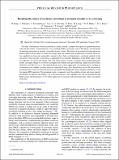| dc.contributor.author | Krockenberger, Y. | |
| dc.contributor.author | McNally, D. E. | |
| dc.contributor.author | Paris, E. | |
| dc.contributor.author | Liang, R. | |
| dc.contributor.author | Hardy, W. N. | |
| dc.contributor.author | Bonn, D. A. | |
| dc.contributor.author | Yamamoto, H. | |
| dc.contributor.author | Schmitt, T. | |
| dc.contributor.author | Kang, Min Gu | |
| dc.contributor.author | Pelliciari, Jonathan | |
| dc.contributor.author | Li, J. | |
| dc.contributor.author | Comin, Riccardo | |
| dc.date.accessioned | 2019-03-14T14:53:54Z | |
| dc.date.available | 2019-03-14T14:53:54Z | |
| dc.date.issued | 2019-01 | |
| dc.date.submitted | 2018-12 | |
| dc.identifier.issn | 2469-9950 | |
| dc.identifier.issn | 2469-9969 | |
| dc.identifier.uri | http://hdl.handle.net/1721.1/120954 | |
| dc.description.abstract | The study of elementary bosonic excitations is essential toward a complete description of quantum electronic solids. In this context, resonant inelastic x-ray scattering (RIXS) has recently risen to becoming a versatile probe of electronic excitations in strongly correlated electron systems. The nature of the radiation-matter interaction endows RIXS with the ability to resolve the charge, spin, and orbital nature of individual excitations. However, this capability has been only marginally explored to date. Here, we demonstrate a systematic method for the extraction of the character of excitations as imprinted in the azimuthal dependence of the RIXS signal. Using this approach, we resolve the charge, spin, and orbital nature of elastic scattering, (para-)magnon/bimagnon modes, and higher-energy dd excitations in magnetically ordered and superconducting copper oxide perovskites (Nd2CuO4 and YBa2Cu3O6.75). Our method derives from a direct application of scattering theory, enabling us to deconstruct the complex scattering tensor as a function of energy loss. In particular, we use the characteristic tensorial nature of each excitation to precisely and reliably disentangle the charge and spin contributions to the low-energy RIXS spectrum. This procedure enables to separately track the evolution of spin and charge spectral distributions in cuprates with doping. Our results demonstrate a new capability that can be integrated into the RIXS toolset and that promises to be widely applicable to materials with intertwined spin, orbital, and charge excitations. | en_US |
| dc.publisher | American Physical Society | en_US |
| dc.relation.isversionof | http://dx.doi.org/10.1103/PhysRevB.99.045105 | en_US |
| dc.rights | Article is made available in accordance with the publisher's policy and may be subject to US copyright law. Please refer to the publisher's site for terms of use. | en_US |
| dc.source | APS | en_US |
| dc.title | Resolving the nature of electronic excitations in resonant inelastic x-ray scattering | en_US |
| dc.type | Article | en_US |
| dc.identifier.citation | Kang, M., J. Pelliciari, Y. Krockenberger, J. Li, D. E. McNally, E. Paris, R. Liang, et al. “Resolving the Nature of Electronic Excitations in Resonant Inelastic x-Ray Scattering.” Physical Review B 99, 4 (January 2019): 045105 © 2019 American Physical Society | en_US |
| dc.contributor.department | Massachusetts Institute of Technology. Department of Physics | en_US |
| dc.contributor.mitauthor | Kang, Min Gu | |
| dc.contributor.mitauthor | Pelliciari, Jonathan | |
| dc.contributor.mitauthor | Li, J. | |
| dc.contributor.mitauthor | Comin, Riccardo | |
| dc.relation.journal | Physical Review B | en_US |
| dc.eprint.version | Final published version | en_US |
| dc.type.uri | http://purl.org/eprint/type/JournalArticle | en_US |
| eprint.status | http://purl.org/eprint/status/PeerReviewed | en_US |
| dc.date.updated | 2019-03-13T15:44:44Z | |
| dspace.orderedauthors | Kang, M.; Pelliciari, J.; Krockenberger, Y.; Li, J.; McNally, D. E.; Paris, E.; Liang, R.; Hardy, W. N.; Bonn, D. A.; Yamamoto, H.; Schmitt, T.; Comin, R. | en_US |
| dspace.embargo.terms | N | en_US |
| dc.identifier.orcid | https://orcid.org/0000-0002-1069-9973 | |
| mit.license | PUBLISHER_POLICY | en_US |
